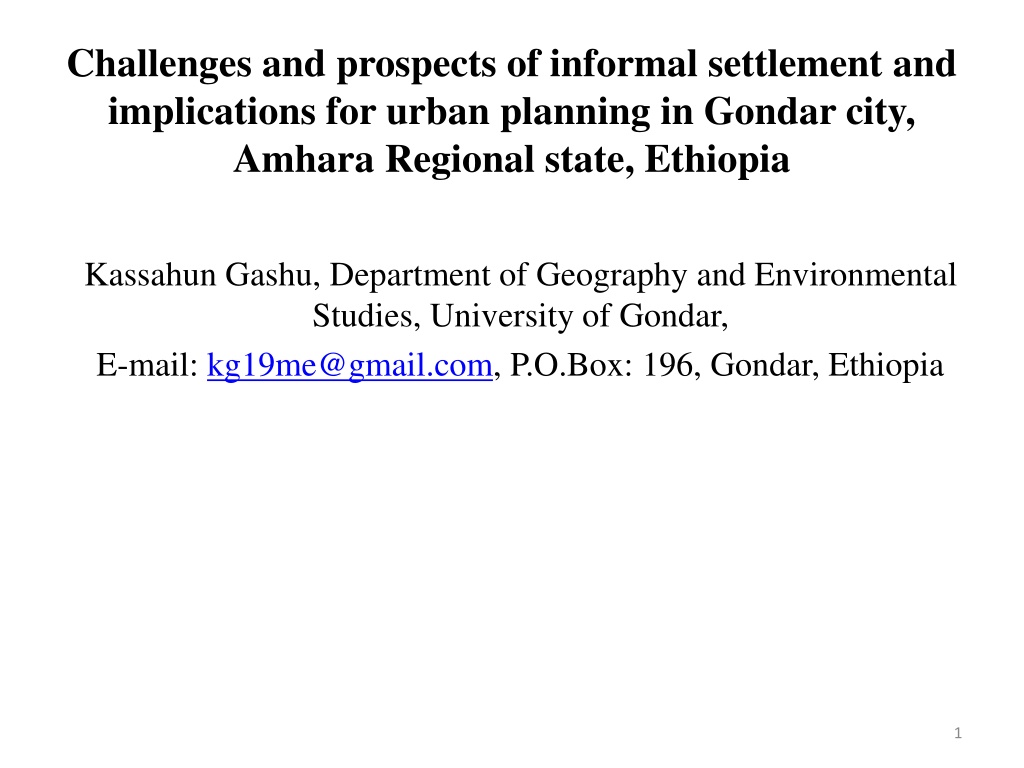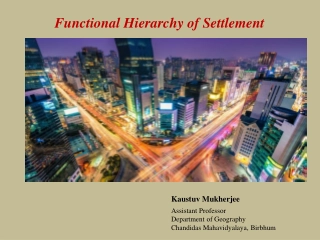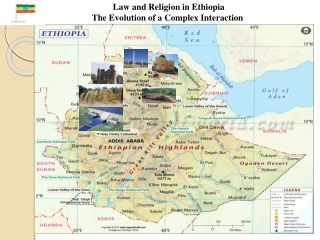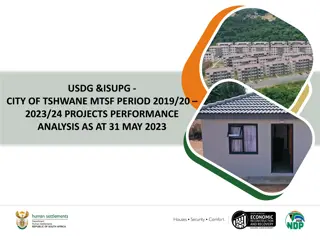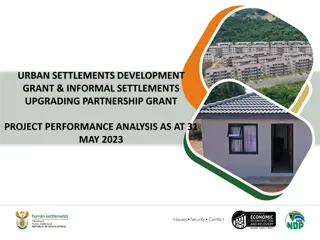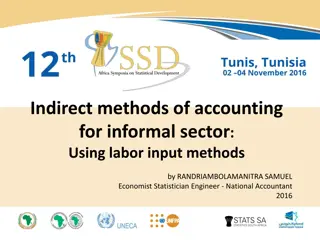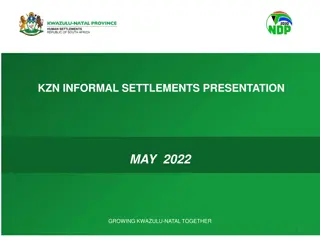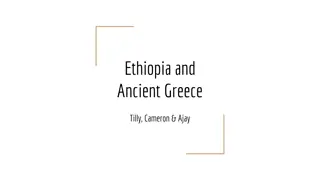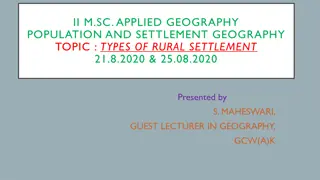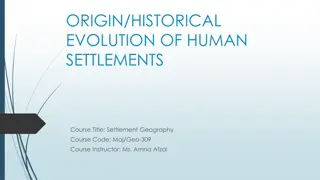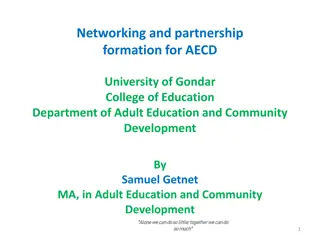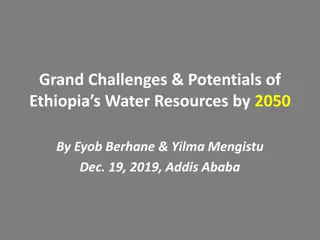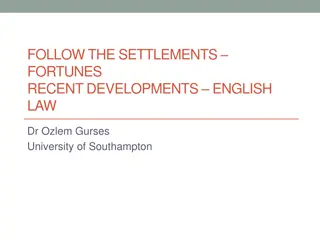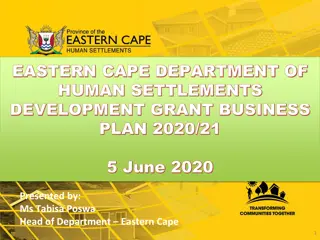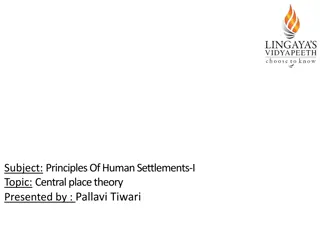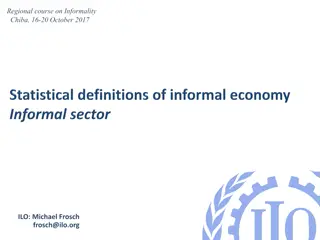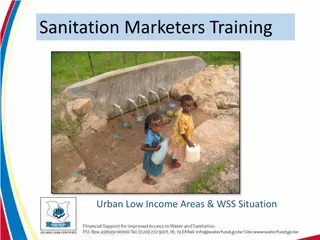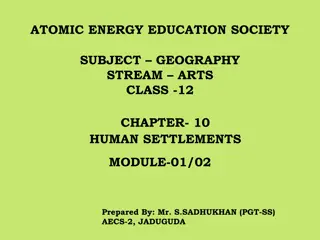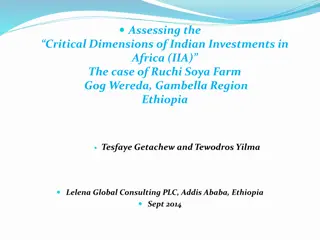Informal Settlements in Gondar City, Ethiopia: Challenges and Prospects
Informal settlements in Gondar city, Ethiopia pose challenges due to lack of tenure security, basic services, and compliance with regulations. Views on their formation range from population growth to political economy factors. Addressing these issues requires a holistic approach in urban planning to improve the living conditions of marginalized communities.
Download Presentation

Please find below an Image/Link to download the presentation.
The content on the website is provided AS IS for your information and personal use only. It may not be sold, licensed, or shared on other websites without obtaining consent from the author. Download presentation by click this link. If you encounter any issues during the download, it is possible that the publisher has removed the file from their server.
E N D
Presentation Transcript
Challenges and prospects of informal settlement and implications for urban planning in Gondar city, Amhara Regional state, Ethiopia Kassahun Gashu, Department of Geography and Environmental Studies, University of Gondar, E-mail: kg19me@gmail.com, P.O.Box: 196, Gondar, Ethiopia 1
Points of presentation: Introduction Problem statement Objectives Analysis & results Way forward 2
Introduction Informal settlements, according to UN-Habitat (2011) are residential areas where Inhabitants have no security of tenure vis- -vis the land or dwellings they inhabit, with modalities ranging from squatting to informal rental housing, The neighborhoods usually lack, or are cut off from, basic services and city infrastructure and not comply with current planning and building regulations, and is often situated in geographically and environmentally hazardous areas. 3
Why informal settlements formed: views Informal settlement views are classified in to three classes: A. Liberal views It is founded based on liberal theories. According to this view, the main reason of creating informal settlements is population and immigration. . In general, increased population is the main factor of developing such views and its solution is controlling the population (Dadash pour & Alizade, 2011). 4
B. Fundamentalist views Come in to being since 1970s forming marginalization of informal settlement tries to discern the reasons of informal settlement is space political economy (Ahadiyan & Shaker Ardakani, 2013). In contrast to liberal view, space political economy investigates genesis of different settlements trying to be involved in the issue origins. This view assigns mono-city of urban system and its heterogeneity to external factors making any efforts to solve the problem by adjusting working, production, distribution, and consumption structures (Hakimi et al, 2013). 5
C. Socialist or goal-orienting view informal settlement and emerging marginal groups in urban communities of developing countries results from the natural trend of the contrast between work and investment (capital). Goal-oriented perspective in 1980s and 1990s, continuing to the present, expresses why informal settlement and marginalization occur; and, regarding the history of interventions in marginal contexts, in practice, opposed to concepts of destruction; it mostly considers notions like empowerment, improvement, and renovation. 6
Around one quarter of the worlds urban population continues to live in informal settlements. Since 1990, 213 million informal settlers have been added to the global population. Over 90% of urban growth is occurring in the developing world and an estimated 70 million new residents are added to urban areas of developing countries each year. Over the next two decades, the urban population of the world s poorest regions-Sub-Saharan Africa is expected to double, suggesting that the absolute numbers of informal settlement and slum dwellers in these regions will dramatically grow. In Africa, over half of the urban population (61.7%) lives in informal settlements and by 2050, Africa s urban dwellers are projected to have increased from 400 million to 1.2 billion. 7
Statement of the Problem Debate on informal settlements has been a centre of concern for many researchers (UN-Habitat, 2007). Ethiopia is one of the least urbanized countries in the world. Even by African standards, the level of urbanization is low. An increasing number of people try to solve their housing needs by getting a plot of land informally in the transitional peri-urban areas 8
The average level of urbanization for Africa in general was 36% in 2002; Ethiopia had only 20% of its population living in urban areas. Despite the low level of urbanization and the fact that the country is predominantly rural, there is rapid rate of urban growth, which is currently estimated at 5.6% per year (MUDH, 2015). Population of Gondar city is increasing at alarming rate every year. It is evidenced by observing the following five recent years of increment in 2014(306,246), in 2015(323,387), in 2016(341,991), and in 2017(360,600) (MUDHCo & ESCU,2015). 9
In many cities and towns major informal settlements are found in the peripheral areas, where they are characterized by their irregular shape and large plot sizes. As a result, they have significantly contributed to the unplanned and rapid horizontal expansion of the built-up area. As a result of rapid horizontal expansion and the spontaneous growth, Gondar city is now confronted with different types of problems, one of which is the emergence and development of informal settlements. 10
Illegal building and illegal land uses are very common practices in the city. The number of informal settlers who were registered as informal settlers in Gondar city was about 700 households (Belachew, 2010). This number increases and the city land supervision report indicated that about 2187 informal settlers were registered in seven kebeles only (Municipality of Gondar city, 2011/2012). Therefore, this study focuses on the challenges and prospects of informal settlements in the Gondar city taking Makaraki and Azezo Demaza sub-cities as sample of study. 11
Study Objectives The general objective of the study is to assess the challenges and prospects of informal settlements and the policy implications in the light of urban planning in Gondar city. The specific objectives are to: Describe main causes of informal settlement in the study area Make some way forward to help to alleviate the problem of informal settlement and its negative consequences. 12
Conceptual framework Informal settlement Challenges Cause of informal settlement Opportunities -problem of getting utilities - Assets/land access -High demand and limited supply of land -Informal land use -Job opportunity -good governance problem -brokerage/doing business -Weak governance -Substandard house -Location -Inefficiency of lease system - Lack of Planning and regulation Implications for Urban Planning Positive-Policy formulation to improving land management Negative -Infrastructure deficiency; Conflict of ownership 13
Research Methodology employed a mixed approach. The qualitative: interview& observation The quantitative: survey questionnaire Sampling Techniques and Sample Size Representative samples were purposely selected from Maraki and Azezo-Dmaza sub-cities in Gondar city. The main logic behind selecting the two kebeles is because of the high prevalence of informal settlement. Respondents were selected proportionately in accordance with the sampling frame from the two kebeles. The sample size determination for the respondents was calculated based on Yamane s statistical formula 14
Table 1: Number of sample size in the study area Kebele name Household Number Sample size Maraki kebele 439 186 Azezo-Dmaza 105 45 Total 544 231 For analysis purpose, the quantitative data were summarized using descriptive statistics (percentage and mean value) while the qualitative data were transcribed and analyzed using text-analysis techniques 15
Description of the study Area Map of study area 16
Table 2: Extent of Urban expansion in the Cities of Amhara region No. Name of City Periods Considered to Measure Settlement Annual Rate of Settlement Expansion Population Growth Rate (%) Extent of Sprawl Used by the CSA to Project Between 1994- Option 1 Option 2 2007 Expansion the Population (%) Census Option 1 2.5 Option 2 1 Bahir Dar 3.7 2.75 2005-2013 1.1 fold * 2 Debre Markos 2.5 1.8 3.38 2006-2013 1.4 fold 1.9 fold 3 Dessie 4 Gondar 2.5 2.5 1.6 4.7 4.5 2005-2013 2006-2013 1.8 fold 4.2 fold 2.8 fold 2.2 fold 10.42 17
Category 30-35 36-40 41-45 46-50 51-55 56-60 Female Male Married Unmarried Divorced Widowed Income from employment Pension and grants Income sent from another household Trade Agriculture Total <100 100-300 301-500 > 500 Electricity Gas Wood Coal Animal dung Wood and animal dung Gas, coal, wood, and animal dug Wood coal and animal dung N % Age 51 73 46 40 1 2 122 91 133 71 23.9 34.3 21.6 18.8 .5 .9 57.3 42.7 62.4 33.3 1.4 2.8 58.2 11.3 23.0 3.8 3.8 100.0 13.6 43.7 18.3 25.5 3.3 4.2 47.4 11.7 9.9 15.5 3.3 4.7 Sex Marital Status 3 6 124 24 49 Source of Income 8 8 213 29 93 39 55 Monthly Income 7 9 Source of Energy 101 25 21 33 7 18 10
Results and analysis Major Causes of Informal Settlement 60 Imbalance between demand and supply 52.6% 50 Weak land governance 40 30 12.7% 23% Location 11.7% 20 Combined factors 10 0 19
This study shows that rapid urbanization and influx of people to urban area(location), weak land governance/lack of development control mechanisms, imbalance between demand &supply/inadequate formal land distribution, poverty and socio cultural factors are major causes of informal settlements 20
The challenges Challenges Maraki Azezo dimaza N 6 13.33 5 Total number Total Percent 22.08 N % 24.19 11.83 % Power supply problem Problem of accessibility to main road Tapped water supply problem High crime rate Concurrent problems (combinations of problems) Total 45 22 51 11.11 27 11.69 25 13.44 9 20.0 14.72 34 15 8.06 3 18 7.79 6.67 79 42.47 22 48.89 43.72 101 186 100.0 45 100.0 231 100.0 21
Nearly half of the participants (43.72%) reported the existence of concurrent problems of power supply, water supply, But the singled most dominant problem reported was power supply which accounted 22.08% of the challenges followed by tapped water supply accounted for 14.72% 22
Mediators of informal settlement Social and relative relationships(traditional social institutions) 9.09% 32.47% Religious relations Land broker 54.98% Speculator 3.46% 23
Major Impacts of the informal Settlements Environmental Impacts Pollution of Water Sources Solid and Liquid Wastes Flooding Deforestation Economic and Social impacts Encroachment of Good Agricultural Land Haphazard or uncoordinated development Live in houses constructed with substandard materials Crime 24
Figure 2: partial view of informal settlement Maraki sub-city (Koshie Sefer ) 25
Figure 2: partial view of informal settlement Maraki sub-city (Zelan Sefer) 26
Summary Large fraction of peri-urban agricultural land is highly subjected for unauthorized conversion. The inaccessible and unplanned peri-urban area is the best alternative place for low-income households. Local peri-urban landholders are the principal suppliers of land for informal market. Land transaction in the informal market is mainly governed by trust and social sanction measures. The hostile attitude of the government towards informal settlements should have to be revisited. 27
The way forward: Participatory informal settlement upgrading: to address urban development imbalances represented by informal settlements. It engages and puts all key urban stakeholders all levels of government, community representatives, civil society, non-government organizations, academia, private sector and, especially, informal settlers at the heart of the process Bull dosing or demolition and carrot and stick is not recommended strategy b/c of human rights using cadaster systems for spatial plan and urban land management and administration(modern technologies) Land is an important resource and it has to be used in appropriate and planned manner This helps to prevent illegal settlements ahead of building i.e. failing to plan is planning fail. 28
Government Leadership: National government must play a leading role in recognizing informal settlement challenges. provide the enabling environment to develop and implement the appropriate policies and plans, i.e. pro poor urban dwellers policies. Actively working with regional and municipal governments connect key stakeholders, harness local knowledge, enact policies and plans and manage incremental infrastructure development. 29
Systemic and city-wide scale approaches: This includes efforts to 1) ensure equitable land management approaches, 2) recognize the multiple forms (formal and informal) of livelihood 3) improve and reintegrate informal settlements with trunk infrastructure and basic services via integrative planning and design, 4) clarify the administrative responsibility of peri-urban areas Infill development, Housing at the centre: strategic and integrated approaches to urban development must put housing at the centre of policy and urban contexts. 30
Thank you for your patience 31
